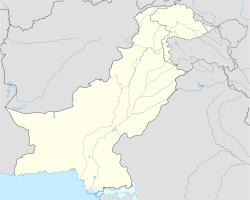Bostan, Pishin
This article may need to be rewritten to comply with Wikipedia's quality standards. (October 2023) |
Bostan
بوستان | |
|---|---|
| Coordinates: 30°15′N 67°00′E / 30.25°N 67.0°E | |
| Country | |
| Province | Balochistan |
| Elevation | 1,593 m (5,226 ft) |
| Time zone | UTC+5 (PST) |
Bostan (بوستان) is a town, 30 km by road (18.64 mi) from Quetta city in the Balochistan province of Pakistan. It is located at (30°25'57N, 67°00'22E) and has an altitude of 1,593 metres (5,229 feet). Bostan is Tehsil of the Pishin District. It was previously included in Tehsil Karezat [1] and covers an area between Mount Takathu and the Red Hills (Bostan clay).
History
[edit]This region was named after Bostan, who was great tribal leader and head of the Panezai clan of the Kakar tribe. Bostan took part in the First Anglo-Afghan War (1839–1842). During the British era, Bostan is a famous railway junction which connecting Quetta with Zhob, Harnai and Chaman. Bostan and Zhob were connected by a narrow gauge railway track which was later dismantled by Panjab through Pashtun leader Nawab Muhammad Ayaz Jogizai around in June of 2008. Now here in Bostan, more of the Bazai tribe than the Panizai tribe are living. They are also a clan of Kakar tribe. Their tribal leaders were Malik Sher Ali Akhund. Mr. Rahim's dad was the father of Malik Sher Ali Akhund who also took part in the British war. The Bostan Takato mountain which rises 3,000 meters. In which about a thousand markhors (Capra's) are found, and here the Bazai nation has given 800 acres of land for industrial zone on which various industries will be built.
The total length of this railway from Bostan to Zhob was 294 km, which made it the longest narrow gauge railway of the subcontinent in 1920s. It had 11 stations in between including the famous Kan Mehtarzai station which was the highest station in Pakistan at an altitude of 2,224 meters (7,295 feet). For a long part of its journey, the railway followed the Zhob River and thus it was called the Zhob Valley Railway (ZVR).
Chronology of Bostan Zhob Railway
[edit]- 1916: Work started on Khanai – Hindubagh section of ZVR.
- 1 January 1921: 74.7 km (46.12 mi) long Khanai to Hindubagh Narrow gauge track was completed
- 2 May 1927: 62.93 km (38.85 mi) long Hindubagh to Qila Saifullah section of NG line was opened
- 15 January 1929: 143.62 km (88.66 mi) long Qila Saifullah to Fort Sandeman (now called Zhob) section of NG line was opened. Only goods traffic started on this section on this date.
- 15 July 1929: Passenger service started from Qila Saifullah to Fort Sandeman (now Zhob)
- Year 1932 Bostan Harnai track dismantled for political reasons.
- 20 November 1939: 15.84 km (9.78 mi) long Khanai to Bostan Jn NG was opened
- 1985: Bostan to Zhob Narrow Gauge line was closed down for passenger service
- 1986: Bostan to Zhob Narrow Gauge line was closed down for freight service
- 2007–08: Narrow gauge track was uprooted and auctioned off for roughly Rs 300 million
References
[edit]- ^ Tehsils & Unions in the District of Pishin – Government of Pakistan Archived 26 March 2012 at the Wayback Machine
- ^ "Zhob Valley Railway (ZVR) of Pakistan". 5 June 2008.

